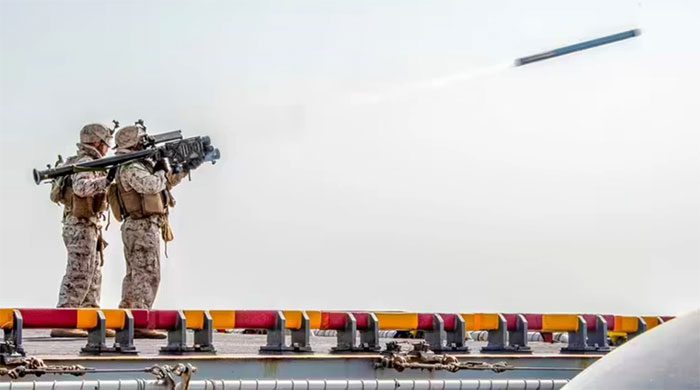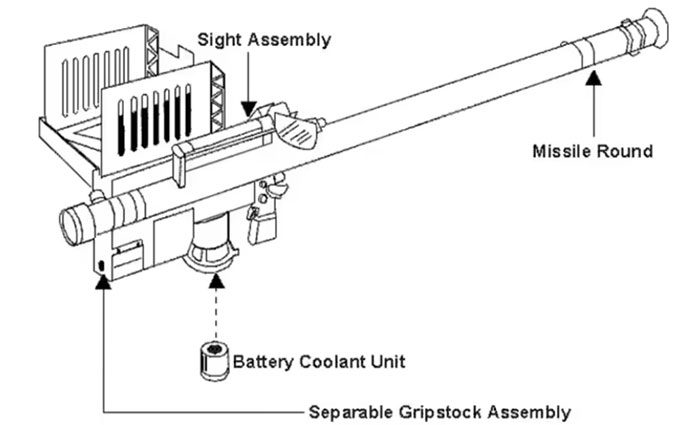Although developed in the early 1970s, the Stinger missile remains one of the most formidable weapons today due to its high accuracy and flexibility.
When Russia launched its special military operation in Ukraine in late February, the Ukrainian defense forces, primarily composed of infantry, were highly vulnerable to attacks from the opposing side’s helicopters. This is why the United States and its NATO allies, such as Germany, decided to provide Ukraine with a powerful weapon to gain an advantage as fighting erupted. That weapon is the Stinger air defense missile system.

The Stinger missile has a speed of twice the speed of sound and a range of nearly 8 km. (Photo: U.S. ARMY).
How the Stinger Missile Works
The Stinger missile, officially designated as FIM-92A, is designed to provide infantry with a means to engage low-flying aircraft and helicopters. From the perspective of ground soldiers, enemy aircraft flying at low altitudes often represent a significant threat, as these vehicles typically appear with the intent to bombard cities, causing substantial casualties with machine guns or direct bombing.
Typically, shooting down these aircraft is the easiest way to eliminate threats, and the Stinger missile excels at this task. The entire structure of the missile includes a guidance system, control fins, a propulsion system, and a warhead.
The tail of the missile features four folding fins that help stabilize and balance the missile during flight. The guidance system consists of a target seeker, guidance, and control components. The missile’s warhead has an explosive power equivalent to 0.45 kg of TNT, encased in pyrophoric titanium. The propulsion system includes a launch motor and a dual-thrust flight motor, allowing the missile to achieve an average speed of 2,400 km/h, which is twice the speed of sound in air (Mach-2).

Structure of the Stinger missile launch system. (Photo: U.S. ARMY).
The Stinger missile employs passive IR/UV sensors to track targets. When the missile is launched from its launcher, the target it is aimed at may become off-center on the image sensor. When this occurs, a warning system is activated, alerting the missile that it has deviated from its path, and the guidance system must determine how to return to the correct flight path.
The algorithm from the sensor uses the angle of deviation and changes in flight angle proportionally. Specifically, every 1/10 of a second, the missile recalculates its flight angle and makes an adjustment. By self-correcting in this manner, the missile can predict the trajectory of the target similarly to how we predict the path of a moving object, selecting the precise position to “capture” it.
In 2019, the U.S. Army began equipping its Stinger missiles with additional near-launch tubes. This technology allows the missile to destroy drones through direct strikes or by self-detonating when close to them.
Thanks to this upgrade, the Stinger missile provides better defense capabilities for the military when faced with threats from small and agile targets.

To launch the Stinger missile, a soldier simply aims it at the target and waits for the guidance system to “lock” onto the target momentarily. They can then pull the trigger to fire. (Photo: U.S. ARMY).
The Perfect Weapon
The Stinger missile was first put into use in the 1970s. Over the years, it has been tested for effectiveness in numerous conflicts, appearing in many “hot spots” of warfare. Today, they remain in the arsenals of over 19 countries and are utilized by four core components of the U.S. military.
Jim Dubik, a former Army Lieutenant General, stated in an interview with Army Times that the Stinger is a weapon with the potential to be a “game changer,” as it provides ground soldiers with the ability to contest airspace control and hinder the offensive capabilities of the enemy.
The weapon’s effectiveness was demonstrated in the mid-1980s when resistance forces in Afghanistan used Stinger missiles supplied by the Central Intelligence Agency (CIA) to shoot down several Soviet helicopters.

An Afghan guerrilla soldier with a U.S.-made Stinger air defense missile. (Photo: AP).
The primary reason the Stinger missile has become an effective weapon is its high mobility and ease of use in emergency situations. The entire launch system of the Stinger missile is relatively lightweight and highly mobile, with the missile and launcher weighing only about 15 kg.
Consequently, the missile can even be easily launched by a soldier or a trained civilian. For this type of weapon, the shooter simply needs to aim at the target and fire, rather than continuously guiding the missile with radar. This allows them to employ flexible tactics, continuing to hide, moving to a new position, or attacking another target.
Additionally, the Stinger missile is often mounted on the AH-64 Apache attack helicopter of the U.S. Army as a strategic air-to-air weapon or mounted on ground vehicles.
Besides its flexibility, the Stinger missile also boasts very high accuracy, as this system uses infrared targeting devices to “lock” onto targets, typically relying on the heat emitted from the engine’s exhaust, and will hit nearly anything flying below an altitude of 11,000 feet (3,352 meters).
This operational method has led to the Stinger being referred to as a “passive seeker,” as it does not use radio waves like some radar-guided missiles. They can hit targets flying up to 3,500 meters high, with a range of approximately 8 km.


















































